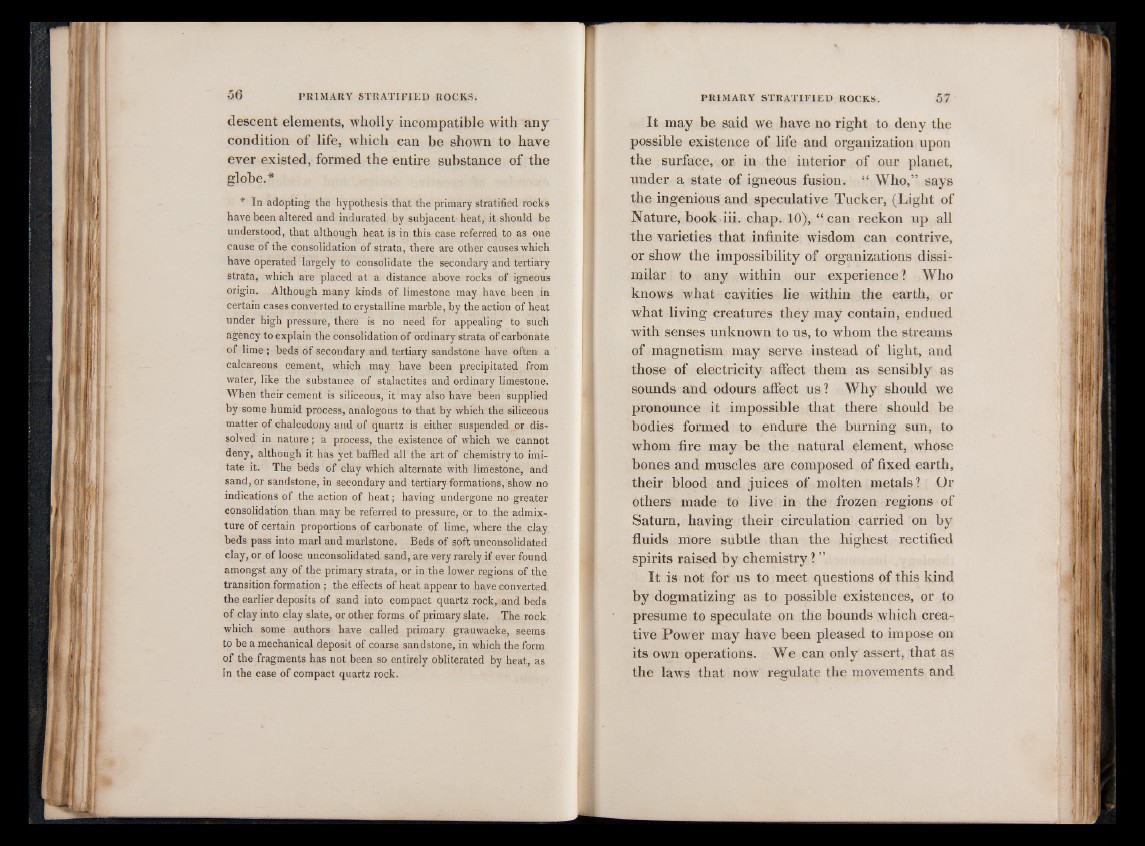
descent elements, wholly incompatible with any
condition of life, which can be shown to have
ever existed, formed the entire substance of the
globe.*
* In adopting the hypothesis that the primary stratified rocks
have been altered and indurated by subjacent- heat, it should be
understood, that although heat is in this case referred to as one
cause of the consolidation of strata, there are other causes which
have operated largely to consolidate the secondary and tertiary
strata, which are placed at a distance above rocks of igneous
origin. Although many kinds of limestone may have been in
certain cases converted to crystalline marble, by the action of heat
under high pressure, there is no need for appealing to such
agency to explain the consolidation of ordinary strata of carbonate
of lime ; beds of secondary and tertiary sandstone have often a
calcareous cement, which may have been precipitated from
water, like the substance of stalactites and ordinary limestone.
When their cement is siliceous, it may also have been supplied
by some humid process, analogous to that by which the siliceous
matter of chalcedony and of quartz is either suspended or dissolved
in nature ; a process, the existence of which we cannot
deny, although it has yet baffled all the art of chemistry to imitate
it. The beds of clay which alternate with limestone, and
sand, or sandstone, in secondary and tertiary formations, show no
indications of the action of heat; having undergone no greater
consolidation than may be referred to pressure, or to the admixture
of certain proportions of carbonate of lime, where the clay
beds pass into marl and marlstone. Beds of soft unconsolidated
clay, or of loose unconsolidated sand, are very rarely if ever found
amongst any of the primary strata, or in the lower regions of the
transition formation; the effects of heat appear to have converted
the earlier deposits of sand into compact quartz rock, and beds
of clay into clay slate, or other forms of primary slate. The rock
which some authors have called primary grauwacke, seems
to be a mechanical deposit of coarse sandstone, in which the form
of the fragments has not been so entirely obliterated by heat, as
in the case of compact quartz rock.
It may be said we have no right to deny the
possible existence of life and organization upon
the surface, or in the interior of our planet,
under a state of igneous fusion. “ Who,” says
the ingenious and speculative Tucker, (Light of
Nature, book-iii. chap. 10), “ can reckon up all
the varieties that infinite wisdom can contrive,
or show the impossibility of organizations dissimilar
to any within our experience ? Who
knows what cavities lie within the earth, or
what living creatures they may contain, endued
with senses unknown to us, to whom the streams
of magnetism may serve instead of light, and
those of electricity affect them as sensibly as
sounds and odours affect us? Why should we
pronounce it impossible that there should be
bodies formed to endure the burning sun, to
whom fire may be the natural element, whose
bones and muscles are composed of fixed earth,
their blood and juices of molten metals? Or
others made to live in the frozen regions of
Saturn, having their circulation carried on by
fluids more subtle than the highest rectified
spirits raised by chemistry ? ”
It is not for us to meet questions of this kind
by dogmatizing as to possible existences, or to
presume to speculate on the bounds which creative
Power may have been pleased to impose on
its own operations. We can only assert, that as
the laws that now regulate the movements and